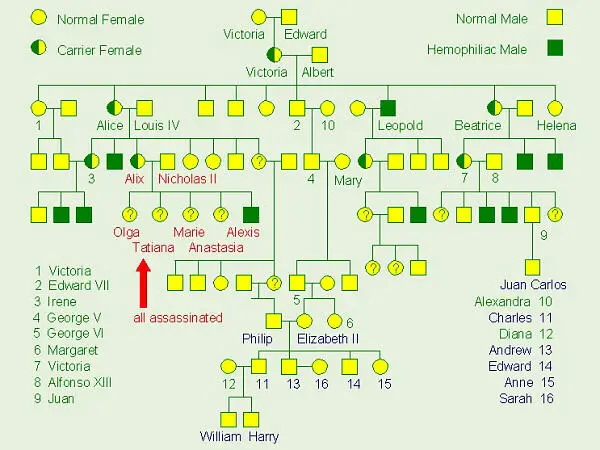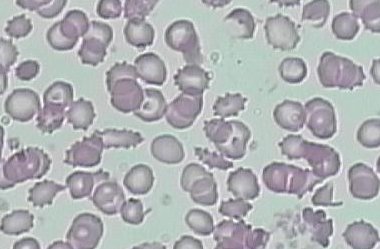| Chromosomes & Human Inheritance All Materials © Cmassengale |  |
Chromosomes:
- Thomas Sutton in 1902 proposed that genes are located on chromosomes
- Called the Chromosome Theory of Inheritance
- For most of the life of the cell, chromosomes are too elongated to be seen under a microscope & are called chromatin
- Before a cell gets ready to divide, each chromosome is duplicated & condenses into short structures
- Each chromosome is composed of a single, tightly coiled DNA molecule
- The two DNA strands are homologous (duplicates) and are held together by the centromere
- While they are still attached, the duplicated chromosomes are called sister chromatids

- Fertilization restores the diploid chromosome number and paired condition for alleles in the zygote
- Chromosomes can be categorized as two types — autosomes & sex chromosomes
- Autosomes are non-sex chromosomes that are the same number and kind between sexes
- Sex chromosomes determine if the individual is male or female
- Sex chromosomes in the human female are XX and those of the male are XY
- Males produce X-containing and Y-containing gametes; therefore males determine the sex of offspring
Chromosome Numbers:
- All animals have a characteristic number of chromosomes in their somatic or body cells called the diploid (or 2n) number.
- The gametes or sex cells (egg & sperm) contain half the number of chromosomes as a body cell; known as the haploid number (n) of chromosomes
| Diploid (2n) numbers of Organisms | |
| Man | 46 |
| Dog | 78 |
| Fruitfly | 8 |
| Crayfish | 200 |
| Corn | 20 |
Pedigrees:
- Also called a family tree
- Squares represent males and circles represent females
- Horizontal lines connecting a male and female represent mating
- Vertical lines extending downward from a couple represent their children
- A shaded symbol means the individual possess the trait
- Half-shaded symbols are carriers

Sex Linkage:
- Thomas Hunt Morgan worked with fruit flies & confirmed that genes were on chromosomes
a. Fruit flies are cheaply raised in common laboratory glassware
b. Females only mate once and lay hundreds of eggs
c. Fruit fly generation time is short, allowing rapid experiments - Experiments involved fruit flies with XY system similar to human system
- Besides genes that determine sex, sex chromosomes carry many genes for traits unrelated to sex
- X-linked gene is any gene located on the X chromosome that are missing on the Y chromosome
- X-linked alleles are designated as superscripts to X chromosome
- Newly discovered mutant male fruit fly had white eyes

Mutant White-eyed & Wild, Red-eyed
- Cross of white-eyed male with dominant red-eyed female yield expected 3:1 red-to-white ratio; however, all white-eyed flies were males
- An allele for eye color on the X but not Y chromosome supports the results of the cross
- Heterozygous females are carriers that do not show the trait but can pass it on
- Males are never carriers but express the one allele on the X chromosome
- Red-green color-blindness is X-linked recessive
- In humans, another well-known X-linked traits is hemophilia (free bleeders that lack clotting factors in their blood)
- One of the most famous genetic cases involving hemophilia goes back to Queen Victoria who was a carrier for the disorder and married Prince Albert who was normal
- Their children married other royalty, and spread the gene throughout the royal families of Europe
 |
|---|
Example Sex-Linked Problems:
1. What are the results of crossing a colorblind male with a female carrier for colorblindness?
Trait: Red-Green Colorblindness | ||||
Alleles: XC normal vision | ||||
XCXc x Xc Y | ||||
| XC | Y | Genotypes: | XCXC ,XCY, XCXc, XcY | |
| XC | XCXC | XCY | Genotypic Ratio: | 1:1:1:1 |
| Xc | XCXc | XcY | Phenotypes: | normal vision female, normal vision male, female carrier, colorblind male |
2. What are the results of crossing a colorblind male with a colorblind female?
Trait: Red-Green Colorblindness | ||||
Alleles: XC normal vision | ||||
XcXc x Xc Y | ||||
| Xc | Y | Genotypes: | XcXc , XcY | |
| Xc | XcXc | XcY | Genotypic Ratio: | 1:1 ratio |
| Xc | XcXc | XcY | Phenotypes: | colorblind female, colorblind male |
| Phenotypic ratio: | 1:1 ratio | |||
Linked genes:
- Each chromosomes has 1000’s of genes
- All genes on a chromosome form a linkage group that stays together except during crossing-over
- Some genes located on the same chromosome tend to be inherited together
- Linked genes were discovered by Thomas Hunt Morgan while studying fruit flies
- Linked alleles do not obey Mendel’s laws because they tend to go into the gametes together
- Crosses involving linked genes do not give same results as unlinked genes
Chromosome Mapping:
- Recombinants result from chromosome crossing over during prophase I of meiosis
- Geneticists can use recombination data to map a chromosome’s genetic loci (position on a chromosome)
- A genetic map lists a sequence of genetic loci along a particular chromosome
- Alfred Sturtevant, a student of Morgan, reasoned that different recombination frequencies reflect different distances between genes on a chromosome
- The farther apart genes are, the greater likelihood of crossing-over
- The closer together two genes are, the less likely of crossing-over occurring
- A map unit equals 1% recombination frequency
- If 1% of crossing-over equals one map unit, then 6% recombinants reveal 6 map units between genes
- To determine the frequency of recombinants, the following formula is used:
| Number of recombinants x 100% | ||
| Recombination Frequency | = | ——————————————— |
| Total Number of Offspring |
- Humans have few offspring and a long generation time so biochemical methods are used to map human chromosomes (Human Genome Project)
Chromosome Mutations:
- Mutations are changes in genes or chromosomes that can be passed on to offspring
- Mutations increase the number of variations that occur
- Chromosomal mutations include changes in chromosome number and/or structure
- Monosomy occurs when an individual has only one of a particular type of chromosome
- Turner syndrome (X0) is an example of monosomy
- Trisomy occurs when and individual has three of a particular type of chromosome
- Examples of trisomy include Klinefelter’s Syndrome (XXY) and Down Syndrome or Trisomy 21 where the individual has three 21st chromosomes
- Both monosomy & trisomy result when chromosomes fail to separate during meiosis; called nondisjunction
- Monosomy and trisomy (aneuploidy) occur in plants and animals and may be lethal (deadly)
- Polyploidy where the offspring have more than two sets of chromosomes occurs often in plants (3n, 4n …)
- Environmental factors including radiation, chemicals, and viruses, can cause chromosomes to break causing a change in chromosomal structure
- Inversion occurs when a piece of a chromosome breaks off & reattaches to the same place but in the reverse order
- Translocation occurs when a chromosome segment breaks off & attaches to a different chromosome
- Deletions occur when the end of a chromosome breaks off & is lost
- Cri du chat syndrome (results in retardation & a cat-like cry) is due to a deletion of a portion of chromosome 5
- Duplications occur when a section of a chromosome is doubled
Fragile X Syndrome caused by an abnormal number of repeats (CCG) results in retardation & long, narrow face becomes more pronounced with age
Gene Mutations:
- Change in genes caused by change in structure of the DNA
- DNA bases may be substituted, added, or removed to cause gene mutation
- When genes are added or removed, the mutation is called a frame shift mutation

- Adding or Removing genes is called a point mutation

- Sickle cell anemia (red blood cells are C-shaped so can’t carry as much oxygen) is an example of a gene mutation in African Americans

- Tay-Sachs (a disorder where the nervous system deteriorates) is a fatal gene mutation in Jewish people of Central European Descent
- Phenylketonuria or PKU occurs from the inability of a gene to synthesize a single enzyme necessary for the normal metabolism of phenylalanine and results in death

